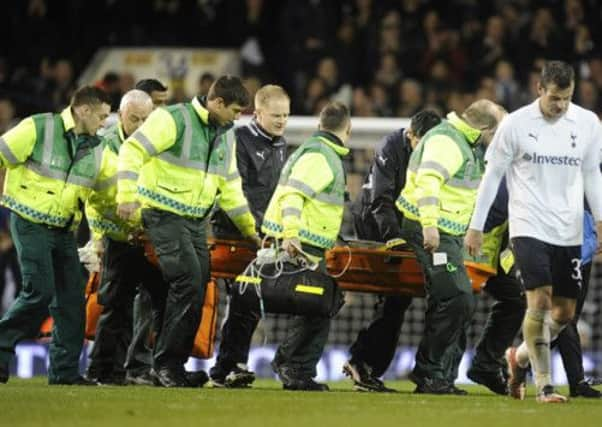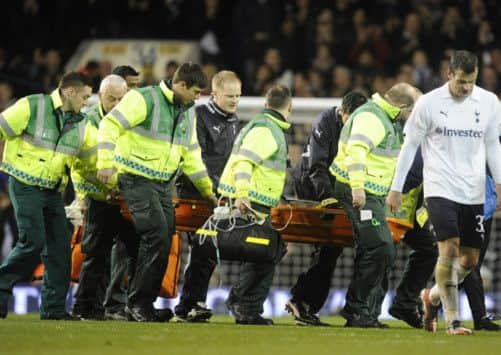Beating the odds with the right care


WHEN England under 21s footballer Fabrice Muamba suffered a cardiac arrest on the pitch he was lucky. He had medical staff on hand who knew exactly what to do to save his life.
Not everyone is so lucky, but it doesn’t have to be a specialist medical team to make a difference, just someone who knows what to do in the event of a cardiac arrest.
Advertisement
Hide AdAdvertisement
Hide AdA campaign launched this week during Heart Rhythm Week by charity Arrhythmia Alliance aims to raise awareness of how ordinary people can help save someone’s life. The campaign has the backing of Muamba who is urging the public to take the Hearts & Goals Challenge, to test knowledge of Sudden Cardiac Arrest (SCA.)


“I’m still standing today because of the difference CPR and early treatment with a defibrillator made to my life. It is vital that people are aware of the life-saving difference they can make when someone suffers sudden cardiac arrest with early CPR and the use of a public-access defibrillator.
“I encourage people to get involved with Heart Rhythm Week, take the Hearts & Goals Challenge to test their knowledge of sudden cardiac arrest and discover the life-saving difference they can make. By knowing the difference, you can make a difference.”
One man who knows just how important it is to get quick treatment is Wakefield sudden cardiac arrest survivor, Chris Solomons.
Advertisement
Hide AdAdvertisement
Hide AdChris, 51, was working as an emergency medical dispatcher for Yorkshire Ambulance Service when he collapsed with a cardiac arrest in July 2010.
He and his colleagues were being filmed for the BBC’s Helicopter Heroes series when Chris collapsed. The entire incident, including the use of a defibrillator twice to restart Chris’s heart and his journey via the air ambulance to hospital were all captured on film.
The grandfather-of-three was rescued by colleagues and went on to make a full recovery, although he still gets emotional when he views the film.
“I set off to work as usual at 6.30 that morning,” recalls Chris.
Advertisement
Hide AdAdvertisement
Hide Ad“En route I stopped off to get some items for the unit at the local store. I had no signs of what was going to happen but as I was travelling down the motorway I started to get pains in my chest. I didn’t think much of it at the time so I carried on driving.”
As the pains worsened Chris decided to pull over and call for assistance but by now things had deteriorated to the point where he couldn’t even use his hands properly. He got back in his car and managed to get to work.
“When I arrived I managed to get in and attract the attention of one of my work colleagues, James Vine, who is a paramedic. He immediately called the other crew member, Lee Davison, who came in with the bag of the aircraft.
“By this time I was in a lot of pain. James and Lee had wired me up and were getting readings showing something pretty serious was going on.”
Advertisement
Hide AdAdvertisement
Hide AdChris was having a massive heart attack, and would later find out one of the main arteries in his heart had become blocked.
A heart attack, or myocardial infarction, is distinct from a sudden cardiac arrest in that it is caused by a plumbing problem.
This is why Chris experienced symptoms but people who suffer sudden cardiac arrest often don’t have any warning and lose consciousness immediately. But heart attacks can lead to sudden cardiac arrest and in Chris’s case what started as a blocked artery quickly became an electrical problem as it caused his heart’s electrical system to malfunction.
“I suddenly went into cardiac arrest and James immediately got me on the floor and started CPR compressions,” continues Chris.
Advertisement
Hide AdAdvertisement
Hide Ad“I was down for about ten minutes as both James and Lee performed CPR on me. As you can see in the footage, they had to use an AED on me twice to shock my heart back into normal rhythm. The next thing I remember is being put into the aircraft and flown to the Leeds General Infirmary to have a stent put into an artery in my heart.
“All this happened within two hours of me getting the first signs of pain.”
Chris was released from hospital after four days and has gone on to make a full recovery and gives talks about his experience.
“Looking back I realise just how lucky I was and now I have recovered I really want to do something good from it,” he says. “I want to raise awareness of this issue and help people understand how important defibrillators are. I know because one helped save my life.” He has now joined up with the Hearts & Goals campaign, and recently got to meet Fabrice Muamba.
Advertisement
Hide AdAdvertisement
Hide Ad“Hearts & Goals is such a great cause and I’m delighted to be involved with the campaign,” says Chris. “I was lucky enough to meet Fabrice at the Reebok Stadium recently which was fantastic.”
Since footage of his dramatic rescue was put on the charity’s YouTube channel in February, it has received more than 150,000 hits, with people around the world contacting Chris to find out more about his incredible rescue.
“I just couldn’t believe the response the video has got, it has been absolutely amazing and I have had people from all over the world commenting and contacting me on the back of,” says Chris who joined the Yorkshire Ambulance Service in 1994 after leaving the RAF.
“Watching the footage back is still surreal and at first it was really hard. It just brings it home to me how lucky I was. I’ve been able to experience so much and if it wasn’t for the guys doing CPR on me and the AED they used I wouldn’t be here. I cannot say strongly enough how important it is that AEDs are in communities. Not in locked cupboards, but out there, placed where they are needed.”